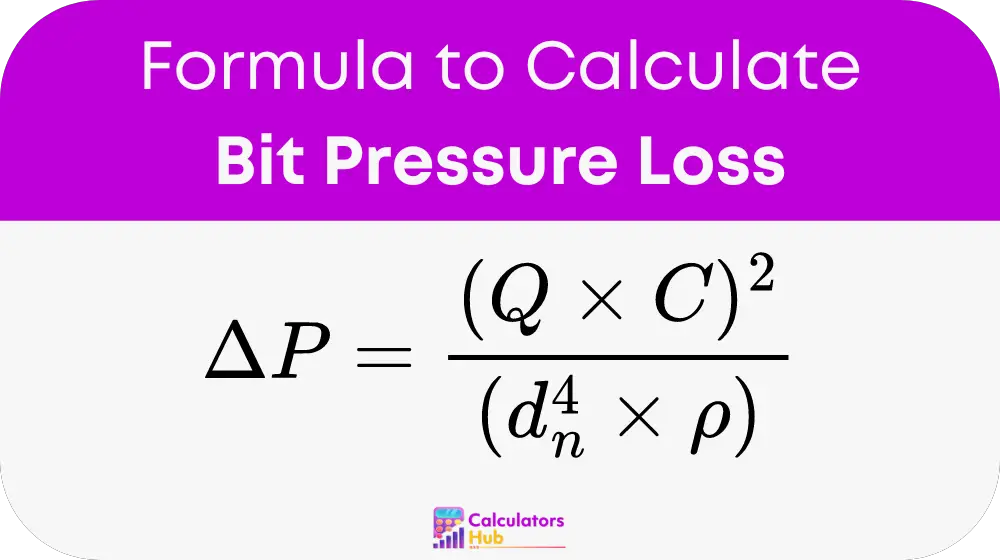The Bit Pressure Loss Calculator is used to estimate the pressure loss occurring in the drilling bit of a wellbore. This calculation is crucial in various drilling operations, especially in oil and gas industries, where efficient fluid dynamics are essential for effective drilling. The pressure loss occurs due to the resistance faced by the drilling fluid as it flows through the bit nozzles and can significantly impact drilling performance and operational efficiency.
Formula of Bit Pressure Loss Calculator
The formula used by the Bit Pressure Loss Calculator is:

Where:
- ΔP: Bit pressure loss (in psi or Pa)
- Q: Flow rate of the drilling fluid (in gallons per minute, GPM, or cubic meters per second, m³/s)
- C: Discharge coefficient (a dimensionless constant, typically between 0.95 and 1.00)
- dₙ: Diameter of the bit nozzle (in inches or meters)
- ρ: Density of the drilling fluid (in pounds per gallon, ppg, or kilograms per cubic meter, kg/m³)
Steps to Calculate:
- Determine the Flow Rate (Q): Measure or obtain the flow rate of the drilling fluid. This can be in GPM or m³/s, depending on your unit preference.
- Find the Discharge Coefficient (C): Identify the discharge coefficient for your bit. This value is usually between 0.95 and 1.00 and may be provided by the bit manufacturer.
- Measure the Diameter of the Bit Nozzle (dₙ): Obtain the diameter of the bit nozzle. This measurement is critical as it significantly affects the pressure loss.
- Get the Density of the Drilling Fluid (ρ): Determine the density of the drilling fluid, which can be in ppg or kg/m³. This value helps in understanding how the fluid’s density impacts pressure loss.
- Apply the Formula: Substitute all values into the formula to calculate the bit pressure loss. Ensure all units are consistent to get accurate results.
General Reference Table
Here is a reference table for common terms related to bit pressure loss calculations. This table provides quick insights into the typical values and units used.
| Term | Description | Typical Values |
|---|---|---|
| Flow Rate (Q) | Rate at which drilling fluid flows | 100 GPM, 0.1 m³/s |
| Discharge Coefficient (C) | Efficiency factor for the bit nozzle | 0.95 – 1.00 |
| Bit Nozzle Diameter (dₙ) | Size of the bit nozzle opening | 0.5 inches, 0.0127 meters |
| Density of Drilling Fluid (ρ) | Mass per unit volume of the fluid | 8.5 ppg, 1200 kg/m³ |
| Pressure Loss (ΔP) | Loss of pressure in the bit | Varies with conditions |
This table can help users quickly understand common terms and values used in bit pressure loss calculations.
Example of Bit Pressure Loss Calculator
To illustrate the use of the Bit Pressure Loss Calculator, let’s work through an example.
Given:
- Flow Rate (Q): 150 GPM
- Discharge Coefficient (C): 0.98
- Diameter of Bit Nozzle (dₙ): 0.75 inches
- Density of Drilling Fluid (ρ): 9.0 ppg
- Convert diameter to meters: 0.75 inches ≈ 0.01905 meters
- Calculate the bit pressure loss:
ΔP = (150 * 0.98)² / (0.01905⁴ * 9.0)
- ΔP = (147)² / (0.00000131 * 9.0)
- ΔP = 21609 / 0.00001179
- ΔP ≈ 1,832,743 psi
This result indicates the pressure loss in psi, given the provided parameters.
Most Common FAQs
Calculating bit pressure loss is crucial for optimizing drilling operations. Accurate pressure loss calculations help in selecting the right bit and drilling fluid, improving efficiency, and preventing operational issues such as stuck pipe or excessive wear on the bit.
The discharge coefficient, C, is typically provided by the bit manufacturer. It accounts for the efficiency of the bit nozzle. For accurate calculations, use the value recommended by the manufacturer or refer to standard industry values if specific data is not available.
If some values are unavailable, you may use industry-standard approximations or consult with equipment manufacturers for estimated values. For critical operations, obtaining precise measurements is essential to ensure accurate pressure loss calculations.